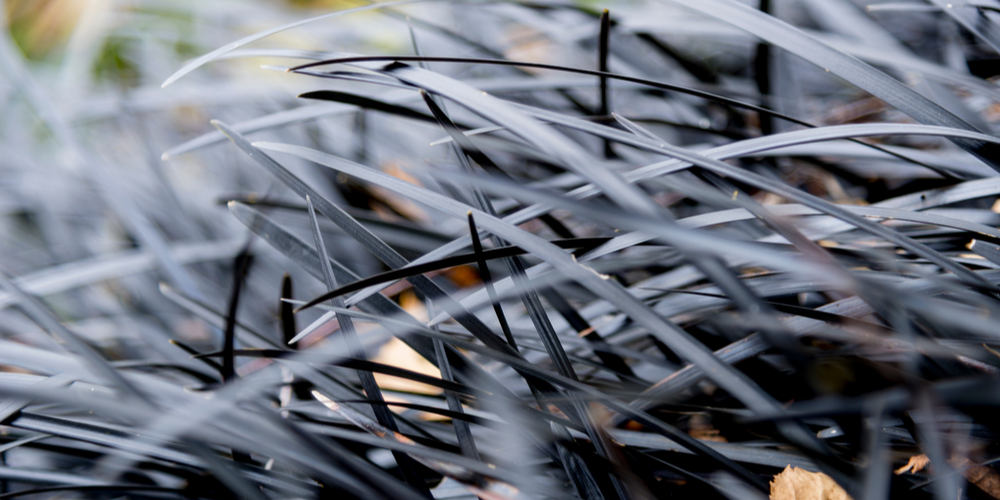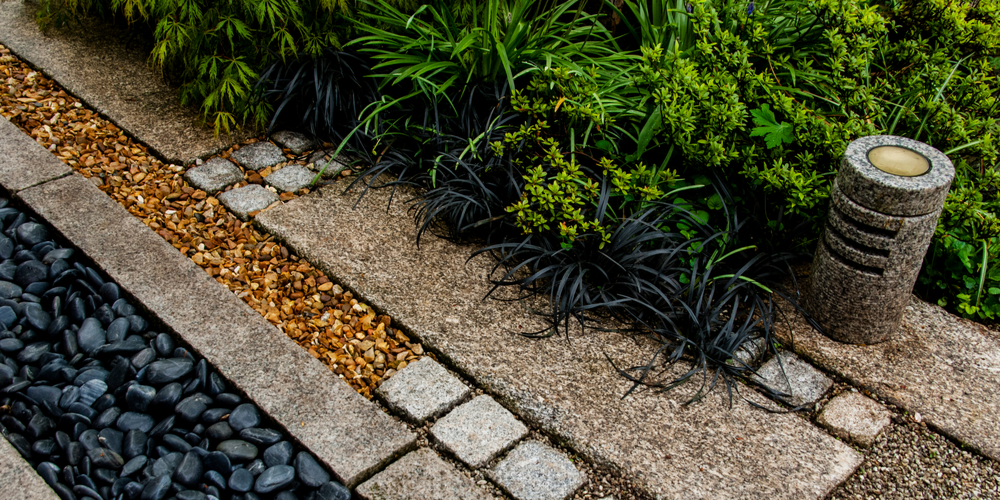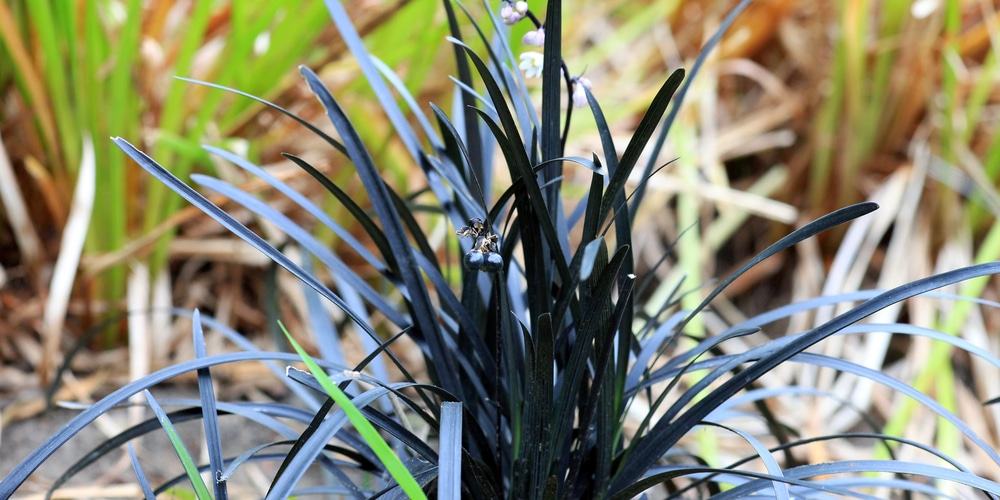Black mondo grass has an architectural appeal like no other groundcover. It has bold, black leaves that make a dramatic statement in the landscape. Its deep purple hue forms tidy clumps that make it an excellent choice for edging or as a border plant.
Prized for its ability to thrive in poor, dry soil and its resistance to diseases, black mondo grass is an easy-care plant that needs less maintenance than many other groundcovers.
If you’re thinking of adding this striking plant to your landscape, here’s what you need to know about black mondo grass care.
| Botanical Name | Ophiopogon Planiscapus |
|---|---|
| Common Name | Black mondo Grass |
| Plant Type | Perennial |
| Flower Color | Delicate and lacy, with lavender petals |
| Size When Mature | 6-12 inches |
| Bloom Time | Early Summer |
| Sun Requirements | Full to Partial Sun |
| USDA Hardiness Zones | 5-10 |
| Soil PH Range | 5.5-6.5 |
| Soil Type | Sandy, slightly acidic, well-draining |
| Water Needs | Medium |
| Native Area | Southern Japan |
What You Need to Know About Black Mondo Grass
Black Mondo Grass is a low-growing, perennial, evergreen plant with long, strap-like leaves that are black in color with a purplish hue. The leaves grow from 6 to 12 inches (15 to 30 cm) long and 1/2 to 1 inch wide when mature.
The plant produces small yet stunning lavender (and sometimes white) bell-like flowers that bloom in the summer and lasts through the fall. These flowers make a great addition to any floral arrangement and are a popular choice due to their unique shape and color. The flowers are followed by blackberries that are poisonous if ingested.
Black Mondo Grass is native to Asia and is commonly found in China, Japan, and Korea. It was introduced to Europe in the 18th century and has been naturalized in some parts of the United States.
How to Care for Black Mondo Grass
Characterized by its stunning black-and-purple foliage, this plant is often used as an ornamental groundcover in the landscape.
Black Mondo Grass requires very little maintenance, but like any other garden plant, it needs sufficient water, sunlight, and nutrients to thrive. Here’s everything you need to know to ensure that your black mondo grass grows and thrives.
Light
Black mondo grass is a beautiful and versatile plant that can add drama and elegance to any garden. Though it is tolerant of both sun and shade, black mondo grass will produce the deepest, most vibrant color in full sun. In shady areas, the leaves may be light green or even yellowish. This gorgeous plant will be the star of your garden if you provide it with a sunny spot in the landscape.
Water and Soil Needs
Black mondo grass grows best in sandy or well-drained humus soil. It tolerates a wide range of soil PH levels but prefers a soil pH of 5.5 to 6.5 to thrive and grow. Consistent moisture is vital for your plant’s health, especially during the hot summer months.
Be sure to water your black mondo grass deeply and regularly to prevent the leaves from turning brown and wilting. You can also mulch around the area to help retain its moisture.
During its first year, regular watering will help your plant become established. Although it is drought-tolerant, black mondo grass thrives best when it receives 1 to 2 inches of water per week. As much as possible, avoid using clay soils because roots may be restricted, and growth will be inhibited.
Temperature Requirements
Black mondo grass is a heat-loving plant that grows best in warm climates. It is winter hardy in USDA zones 5 to 10 and can tolerate temperatures as low as -10 degrees Fahrenheit (-23 degrees Celsius). If you live in a colder climate, you can grow black mondo grass as an annual or bring it indoors during the winter months.
Fertilizer
This plant is slow-growing, and it doesn’t require much fertilizer. In fact, too much fertilizer can actually harm your plant. For best results, apply a balanced fertilizer (10 10 10) in the spring and summer months when the plant is actively growing. Be sure to follow the manufacturer’s instructions to avoid over-fertilizing your plant.
Common Diseases
Although hardy and low-maintenance, this plant is susceptible to a few diseases, including leaf spots and rust. You can treat these problems by removing affected areas of foliage or by spraying the plant with a fungicide.
Root rot is another common issue, especially if the plant is grown in poorly-drained soil. If you notice that your plant’s leaves are wilting or turning brown, it’s likely a sign of root rot. Be sure to provide good drainage and refrain from over-watering to prevent this problem.
On the other hand, underwatering can cause irregular brown spots to appear on the leaves of your plant. If you notice that the tips of your black mondo grass are turning brown, it’s likely a sign of underwatering. To remedy this problem, water the plant regularly and deeply to ensure that its soil is consistently moist. You may also mulch around the plant base to help retain moisture.
Pests
Black mondo grass is a low-maintenance plant that is relatively pest and disease-free. However, it can be susceptible to slugs and snails, as well as spider mites.
If slugs are a problem, try sprinkling diatomaceous earth around the base of your plant to ward them off. You can also spot treat with a slug-bait product that contains iron phosphate if severe infestations occur. For spider mites, use neem oil or insecticidal soap on the underside of the leaves to control them.
Black Mondo Grass Propagation
Although black mondo grass can be divided and transplanted, it is a slow-growing plant that will take years to produce significant growth. To propagate the plant from seed, simply cut off the top of its flower stalk when the flowers begin to fade.
You can expect seeds to emerge within about three weeks. Sow them directly into pots or seed trays filled with moist potting mix. Keep the soil moist and place the pots in a warm, sunny spot. Seedlings should emerge within two to three weeks.
If you’d like to propagate black mondo grass from divisions, dig up the plant in early spring and divide it into clumps. Replant each clump in a sunny area that provides good drainage. Water the plant regularly and keep an eye out for pests or signs of disease to prevent these problems from occurring again.
Related Article: Dwarf Mondo Grass as Lawn
Summary
Black mondo grass is a striking addition to any garden, with its inky black leaves and stately growth habit. Despite its elegant appearance, black mondo grass is surprisingly easy to care for.
These plants are evergreen and tolerant of full sun or partial shade. They prefer well-drained soils and will perform best if they are allowed to dry out slightly between watering.
Black mondo grass is also resistant to deer and rabbits, making it a good choice for gardens that are frequented by these animals. With just a little bit of care, black mondo grass will thrive in nearly any garden setting.
Related Article: How to Grow Dwarf Mondo Grass?


